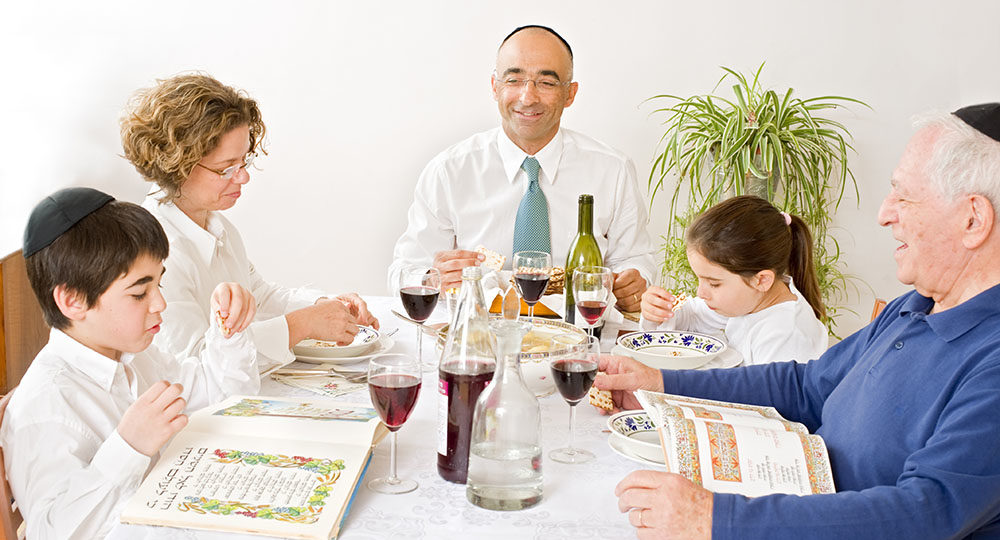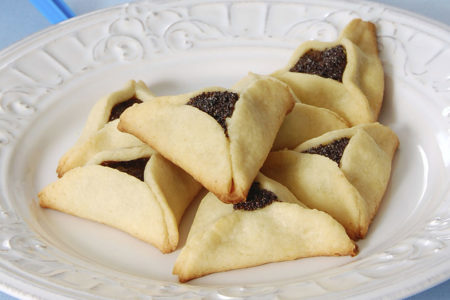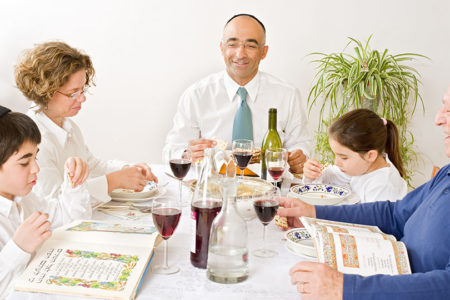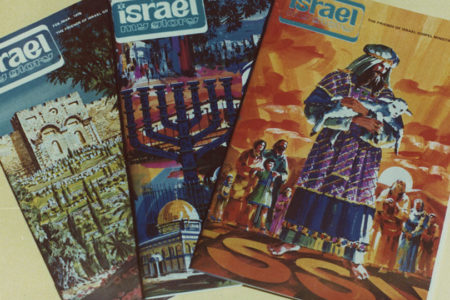Passover
Praised be Thou, O Lord our God, King of the Universe, who has sanctified us with Thy commandments, and enjoined upon us the mitzvah of kindling the Festival lights …
And, in so saying, Jewish women for centuries have ushered in the festival of Pesach, or Passover, on the 15th day of the month of Nisan. The candles are lit, the prayer is said, and Jewish people the world over begin the ceremony commanded by God Himself: “And thou shalt show thy son in that day, saying, this is done because of that which the Lᴏʀᴅ did unto me when I came forth out of Egypt” (Ex. 13:8).
The Purpose
Remembering important events has been part of humanity for a long time. God gave the Jewish people many special days for remembering the great things He had done for them. One of the most important of these days is a feast called Passover. Passover reminds the Jewish people of the last meal eaten while they were in bondage in Egypt. It reminds them of their journey—the exodus—from Egypt to the land that God promised. Passover is a reminder of the redemption wrought when the angel of death passed over the homes where the blood of a lamb had been applied to the lintels of the doors. The Talmud tells the Jewish people that Passover is to remind adults to “impress, inspire and educate” the children. It is a happy time, a joyous time, a time to celebrate.
Preparation for the Passover
Jewish people have been spring cleaning for 3,500 years in obedience to the command found in Exodus 13:7, “no leavened bread [shall] be seen with thee, neither shall there be leaven seen with thee in all thy quarters.” The house is cleaned of all leaven before the arrival of the Passover. Personally, I remember my mother lining the stove, the bread box, and the refrigerator with foil even after a good cleaning, in the event any leaven had been overlooked. The ancient sages say that leaven symbolizes evil and must be dealt with. To further ensure the absence of even a trace of leaven, special dishes are used, as well as special pots and pans to prepare food, none of which will have any leaven in them.
Participants and Practice
Passover is about families. Exodus 12:1–14 tells us the story. Each person in the family has a role to play. The Passover meal is called the Seder, a Hebrew word meaning order. This order has been consistent for at least two thousand years.
The Haggadah (a book of songs, prayers, and various readings) tells the participants what to do and when to do it. The head of the family (traditionally the father or grandfather) sits at the head of the table and directs the proceedings.
The Seder begins with the woman of the home lighting the Passover candles, in the hope that the light of the candles will light the spirits of the family, followed by the other elements of the Seder.
The Kiddush (the blessing of the wine): This cup represents the first of the four I wills spoken by God in Exodus 6:6–7. “I will bring you out from under the burdens of the Egyptians” (v. 6). The wine must be red, to remind the participants of the blood of the lamb.
U-r’hatz (the washing of the hands): Washing is, and always has been, a very important personal and religious function for the Jewish people. Not only does it purify, but it also reminds us of the priests as they prepared themselves for service.
Karpas (the green vegetables): The participants then take parsley (or any green vegetable) and dip it in a bowl of salt water. These two elements speak, respectively, of springtime, which is nature’s renewal, and of the tears that were shed during the two hundred years of bondage in Egypt. The parsley is also symbolic of the hyssop used to apply the blood to the doorposts.
Yachatz (the breaking of the middle matzo): A pouch containing three matzos is taken by the leader. The three matzos represent the classifications of Jewish people: the Kohen, the Levites, and Israel. The rabbis say that the three loaves together represent strength in unity. The middle matzo is taken and broken by the leader, wrapped in white, and hidden away. The part that is hidden is called the Afikomen, or the bread of affliction. It is known in the Passover as the dessert.
The Four Questions: The youngest member of the family has the important task of asking the leader about the Passover and Seder. He wants to know why this night is different from all other nights. He asks:
On all other nights we eat leaven—why on this night only unleavened bread? On all other nights we eat all kinds of herbs—why on this night only bitter herbs? On all other nights we don’t dip even once—why on this night do we dip twice? On all other nights we eat sitting or reclining—why on this night do we eat reclining?
The leader answers these questions by telling the story of the Jewish people to the time when Moses received the Law at Sinai. At this point the second cup of wine is poured. Each participant at the Seder table dips his little finger into his wine and recites one by one, the ten plagues as he puts the drop of wine onto his own plate. In so doing the Jewish people remember the suffering even of their enemies. A prayer for the wine is recited and the second cup is taken. This is the second I will—“I will rid you out of their bondage” (Ex. 6:6).
Pesah (the Paschal lamb): There is no lamb in the Passover service today. Instead, the shank bone of a lamb serves as a reminder of the lambs that were sacrificed yearly before the Temple was destroyed two thousand years ago.
Hazeret (the bitter herbs) and Haroset (a sweet mixture of apples, nuts, and cinnamon): These are eaten together, after the hands have been washed a second time. The bitterness of the herbs recalls the bitter bondage of the Jewish people. The sweetness of the Haroset reminds them of the sweetness of freedom—a bittersweet remembrance. It is then customary to eat the Hillel sandwich, named after the great sage, Hillel. Horseradish (the bitter herbs) is put between two pieces of matzo. In Hillel’s day, a piece of lamb was also used, for Hillel taught that the three biblical elements—bitter herbs, matzo, and the lamb—should all be remembered.
Now, at last, dinner is served, and what a wonderful meal it is! Prior to the destruction of the Temple (70 A.D.) lamb would have been served. Today, however, the traditional meal includes gefilte fish, chicken or roast beef, and kugel Many desserts unique to Passover are served (such as cakes, brownies, or pastries baked with potato flour, thus unleavened).
After the festive meal, a search is made for the Afikomen. The children search high and low for it, knowing that the one who finds it will receive a reward. The rabbis say that the Afikomen is important because the Seder cannot end until each participant has eaten a small piece of it. In so doing they are remembering the lamb. Some rabbis believe that, symbolically, the Afikomen is more important than the shank bone.
The third cup is then taken, accompanied by the third I will—“I will redeem you with an outstretched arm” (Ex. 6:6). Following this third cup of wine, Elijah the prophet is invited to come to the Seder. A place has been reserved for him at the table, with a full glass of wine.
The fourth cup of wine is then taken. It is the last of the four I wills—“I will take you to me for a people, and I will be to you a God” (Ex. 6:7).
In closing the Hallel Psalms (113–118) are sung a prayer is recited, and, in unison, all participants say a hearty “Next year in Jerusalem!”
Practical Application of the Passover
The Feast of Passover was celebrated by Jesus of Nazareth. It was at the Passover that Jesus instituted the Lord’s Supper, or communion. The rich symbolism of the Seder service paints a very clear and revealing picture of Jesus as the promised Messiah and Savior, helping us to better understand this ordinance.
Before the Passover begins, there is a thorough search for leaven. The leaven is then removed from the house. In Judaism, leaven symbolizes evil. When a Christian remembers the Lord in communion, he should search his heart to find any sin and get rid of it by confessing it to God (1 Cor. 11:27–28).
The woman brings the light to the Passover table. Without her, the story of the physical redemption of the Jewish people could not be told. Two thousand years ago, a Jewess named Miriam (we know her as Mary) was the choice vessel of God to bring spiritual redemption to the world. Without her, the story of salvation could not be told.
The three original elements of the Passover were bitter herbs, unleavened bread, and the lamb. Bitter herbs speak of bitter bondage. The believer is to reflect at communion and realize the bitter bondage of sin and the cure for that bondage—the Lamb, Jesus Christ. He was pure, sinless, without spot—just like that unleavened bread.
A great drama takes place with the Afikomen. Three matzos are placed in one pouch. The middle one is taken, broken, wrapped in white, hidden away, found, redeemed, and shared by all. This middle matzo has taken the place of the lamb in importance, as shown by the fact that everyone at the table must partake of it. Traditions associated with the Afikomen add to its drama. European Jews (Ashkenazi) believe it has power to heal the sick. Oriental Jews believe it can calm a stormy sea.
When Christians remember Jesus at communion, they remember that He—the second person in the Godhead—was taken, broken (or killed), hidden away in a tomb, and then raised from the dead. Believers remember Him by taking a little piece of unleavened bread and eating it. The word Afikomen is the only Greek word in the Seder. It means He came. The Afikomen looks back, not at the Passover lamb bringing physical salvation in Egypt, but at the Savior, the Passover Lamb who brought spiritual salvation to the world. Isaiah described this event when he said, “he was wounded for our transgressions, he was bruised for our iniquities; the chastisement for our peace was upon him, and with his stripes we are healed” (Isa. 53:5). Isaiah also said, “he is brought as a lamb to the slaughter” (Isa. 53:7). John the Baptist called Him “the Lamb of God, who taketh away the sin of the world” (Jn. 1:29).
The Jewish people believe that Elijah will announce the Messiah. Each year they set a place for him at the table, waiting and hoping for the announcement. Two thousand years ago Jesus said of John the Baptist, “this is Elijah” (Mt. 11:14). Malachi 4:5 says that Elijah will be sent before “the great and terrible day of the LORD.” Could it be that Elijah will be one of the two witnesses described in Revelation 11, who will appear before the Second Coming of Christ? It is an intriguing question.
In Matthew 26, Jesus instituted communion. He took the unleavened bread, symbolic of His pure and spotless body, and the cup, representing His blood. The cup He took was the third cup, the cup of redemption. He did not drink the fourth cup, saying He would not drink it until He drinks it new with us in His Father’s Kingdom.
Matthew 26:30 speaks of a hymn the disciples sang. We know the hymns they sang because they are still sung at Passover. They are the Hallel Psalms (113–118). “The stone which the builders refused is become the head of the corner … it is marvelous in our eyes. This is the day which the Lᴏʀᴅ hath made; we will rejoice and be glad in it” (118:22–24). This is the day. On the first night Jesus celebrated the Passover, and on the second He became the Passover Lamb on behalf of us all. The lamb had to be perfect with no spot or blemish. “He hath made him, who knew no sin, to be sin for us” (2 Cor. 5:21). The lamb was sacrificed. “Christ, our passover, is sacrificed for us” (1 Cor. 5:7).
The lesson is simple. Jewish or Gentile, old or young rich or poor—on that night in Egypt, the only issue was whether or not the blood was on the doorpost. Sincerity did not count. Good deeds did not count. Degrees and pedigrees did not count. If the blood of the lamb was on the door, death did not come. If there was no blood, death was a certainty.
The requirements have not changed for us today. God still demands a blood sacrifice to atone for sin. But the amazing news is that God Himself provided that sacrifice in His own Son. The price has been paid.
Jesus said, “I am the way, the truth, and the life; no man cometh unto the Father, but by me” (Jn. 14:6).
Is Christ your Passover Lamb?









Could you please explain to me why ‘Passover’ is not mentioned as one of the three Feasts that God mentions that Israel is to partake of in Exodus 20-24? It seems as if I hear that there are ‘seven’ feasts of the Lord, yet Passover seems ‘separate’ than the first three mentioned.